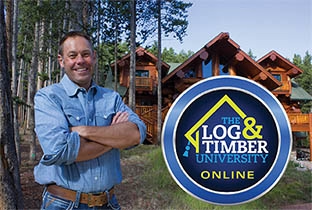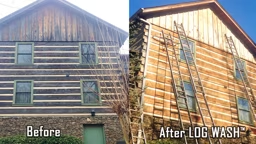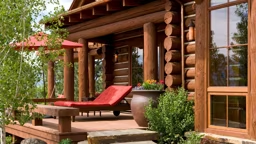
You’re probably aware of the concerns some people have about log home maintenance. Some horror stories have been told about how log homes and log cabins quickly fell into disrepair and thousands of dollars were spent bringing the homes back to their original beauty.
The real story is how the homes got that way in the first place. The homeowners were either unaware of wood upkeep or neglected to take care of their logs. But if you educate yourself and plan ahead, you will have a minimal amount of time, money and effort to place in your log home maintenance regimen.
The following questions should help dispel some of the rumors and put you on the road to a well-maintained log home:
Myth: Log home maintenance takes a lot of time.
Fact:
Are log homes a lot of maintenance? The truth is: they don’t have to be. If you plan ahead and design your home properly, you can save yourself a lot of work. Large overhangs, porches, proper landscaping and tall foundations will prevent maintenance nightmares. A log home is not a conventional home and will require non-conventional maintenance, but as long as you are aware of this up front, you can design and plan for this.
Myth: Log home maintenance is complicated.
Fact:
Not necessarily. So, how DO you maintain a log home? The most important factor is to clean: Clean and dry the wood's surface before and after you stain, and keep the dust, pollen and mold off your logs every season. Pay special attention to the south and west walls of your log home, as they are more susceptible to the elements. If this seems too time consuming, you may want to hire a service that manages the maintenance of your home.
Myth: Log homes have mold problems.
Fact:
All surfaces can have mold problems. The more moisture there is, the more mold will grow. Shady trees, drippy rooflines and backsplash all contribute. Keep an eye on the north side of your home, as it will receive the least amount of sunlight and, as a result, will stay damp longer after a rainfall. If you keep your logs dry and off the ground, they can last at least a lifetime.
Myth: Log homes have insect problems.
Fact:
The industry has come a long way over the last 20 years. We don’t have the termite problems of the past, thanks to the use of borate, a natural mineral that keeps bugs from wanting to eat your logs. The major problem today is carpenter bees, but they, too, can be prevented. The best way to keep carpenter bees from destroying your wood is to use liquid formulations containing permethrin and cyfluthrin and dusts containing boric acid. Once bees are gone, plug holes with steel wool and caulk, followed by a finish stain.
Myth: Log home stains are harmful to the environment.
Fact:
The stains of the past, with high volatile organic compounds (VOCs) that were harmful to the air, have been reformulated to reduce these pollutants. Oil-based stains have been wrongly maligned; water-diluted petrochemical stains are no less “green” than wood stains utilizing modern vegetable oil-based technologies. While designing compliant oil-based stains requires a greater degree of formulating expertise and sophistication than their water-based counterparts, oil-based stains will continue to maintain a strong, viable and eco-friendly presence.
Myth: All log stains are basically the same.
Fact:
Each stain company has its own system and formulations, all working hard to do the best job for the longest period of time, and for the most reasonable price. This has created a multitude of systems across the log home industry. Your best bet it to educate yourself on all the products available and try to determine what will work best for your situation, and ask your log home producer which stains they recommend. The type of wood, the environmental conditions and the age of the home all play a role in the decision making, as do time and price.
Myth: I can buy a good stain from the local hardware store.
Fact:
Low prices and convenience make it tempting to buy stain at a home improvement store, but there could be an unseen cost. For maximum, long-term performance, log homes require specialized stains that contain additives not typically found in your average wood stains and sealants. Your best bet is to find a log home supply store or browse Log Home Living's directory of companies specializing in stains and other maintenance treatments. Alternately, you may want to ask another local log homeowner what they use. A good log home stain is formulated to prevent moisture from entering the fiber of your logs and has the right amount of pigment to prevent sun damage. A log home stain will also give you the best overall look for your home.
Myth: If you live in a dry area you can get by with less staining.
Fact:
A log home stain’s main function is to repel moisture from being absorbed by the wood AND protect the surface from the sun’s damaging UV rays. Dry areas usually have lots of sun and you want to prevent wood degradation. The pigment in the stain helps with this. Large overhangs and porches also can help, but stain is still required to keep the logs in prime condition.
Myth: Oil-based stain is better than water-based stain.
Fact:
Sometimes it is presumed that oil-based stains are better. That is not necessarily so, if the stain is applied according to manufacturers directions and a good maintenance plan is implemented. Depending on sun exposure and humidity levels where you live, any of the stains can be recommended. Color may also be a factor as to the choice of stain-- all stains come in different shades and colors. Oil stain is often thicker and can often hold more pigment than its water-based counterpart.
Remember, oil and water don't mix, so if you have an oil-based stain on your logs already, you must stay with an oil-based product. Be sure and check manufacturer recommendations.
Myth: Cracks in log homes are a problem.
Fact:
Cracks , also called "checks" are a natural characteristic of logs and nothing to worry about, unless they are on the topside of an exterior log where rain, snow and dirt can accumulate. The best prevention method is to clean well, add borate rods to prevent moisture retention, fill with backer rods and then caulk. Make sure that all new cracks are treated with borate, stained, and then caulked.











